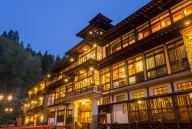Ein Muss für alle Kyoto-Reisenden, die einen musterhaften Tempel besichtigen möchten.
Der Rokuonji-Tempel ist ein berühmter zen-buddhistischer Tempel mit jahrhundertelanger Geschichte, der heute eher als Kinkakuji-Tempel bekannt ist - ein Name, der sich von dem berühmten Goldenen Pavillon (Reliquienhalle) ableitet, der das Herzstück der Tempelanlage bildet. Dieser dreistöckige, mit Blattgold überzogene Pavillon ist eines der berühmtesten und bekanntesten historischen Bauwerke in Kyoto. Der Tempel gehört heute zum UNESCO-Weltkulturerbe und ist für Besucher der grünen Stadt ein Muss.
Nicht verpassen
- Beobachten Sie die Spiegelung des Goldenen Pavillons im ruhigen Kyoko-chi-Teich
- Erleben Sie die einzigartigen Ansichten des Goldenen Pavillons zu jeder Jahreszeit - vor allem sein atemberaubendes, von Schnee umhülltes Winterbild
- Besuchen Sie die üppigen, moosbewachsenen Gärten und das Teehaus auf dem Tempelgelände
Anfahrt
Nehmen Sie den Kyoto City Bus vom JR-Bahnhof Kyoto (Nr. 205). Steigen Sie an der Station Kinkakuji-michi aus. Die Fahrt dauert etwa 45 Minuten.
Kurzinfo
Ursprünglich als Ferienvilla für den Shogun Ashikaga Yoshimitsu im Jahr 1397 bestimmt.
Die Tempelanlage des Kinkakuji umfasst rund 132.000 Quadratmeter.
Die zweite und dritte Etage des Pavillons sind mit Blattgold überzogen
Vom Ferienhaus des Shoguns zum Zen-Tempel
Der im 14. Jahrhundert regierende Shogun Ashikaga Yoshimitsu erwarb das Gelände, auf dem sich heute der Kinkakuji-Tempel befindet, und baute dort sein Ferienhaus, das er Kitayamadono nannte. Nach seinem Tod wurde das Gelände auf seinen Wunsch hin in einen zen-buddhistischen Tempel umgewandelt. Der visuell beeindruckende Goldene Pavillon wurde zu Ehren des Buddha erbaut, und ein zusätzlicher Schrein auf der zweiten Ebene ist Kannon, der Göttin der Barmherzigkeit, gewidmet.
Jedes der drei Stockwerke des Pavillons ist in einem eigenen Architekturstil gebaut. Die erste Ebene: shinden-zukuri, ein architektonischer Stil, der in den Palästen der Aristokratie während der Heian-Zeit (794-1185) vorherrschte. Die zweite Stufe: buke-zukuri, ein Stil, der in den Residenzen hochrangiger Samurai-Krieger der Kamakura-Zeit (1185-1333) üblich war. Die dritte Ebene: die traditionelle chinesische Zen-Architektur. Die strohgedeckten, pyramidenförmigen Dächer jeder Ebene sind mit Schindeln bedeckt, und die obersten beiden Ebenen sind mit dem Blattgold bedeckt, von dem sich der Name des Kinkakuji-Tempels ableitet.
Ein Garten als Tor zur buddhistischen Weltanschauung
Der Garten des Rokuonji-Tempels, der als einzigartiges historisches und landschaftliches Wahrzeichen eingetragen ist, erstreckt sich über eine Fläche von 92.400 Quadratmetern. Das Herzstück des Gartens ist der Kyoko-chi-Teich, der "Spiegelteich", in dem sich das Bild des Goldenen Pavillons spiegelt. In der weiten Wasserfläche befinden sich kleine Inseln unterschiedlicher Größe, wie z. B. die größere Ashiharajima oder die kompakteren Inseln und Steine, die aus der Oberfläche des Teiches herausragen.
Seit 1994 zum Weltkulturerbe ernannt
Die ursprüngliche Struktur des Goldenen Pavillons brannte 1950 ab, wurde aber 1955 auf der Grundlage einer detaillierten Rekonstruktionsinitiative wiederaufgebaut. Aufgrund seiner spektakulären Architektur, die auf einzigartige Weise die Kultur und das vorherrschende Design des Hofadels, der Samurai und des Buddhismus in Einklang bringt, wurde der Pavillon 1994 zum Weltkulturerbe erklärt.
Benachbarte Welterbe-Tempel zu besuchen
Andere nahe gelegene Welterbestätten wie der Ginkakuji Tempel , der Ryoanji Tempel und der Tenryuji Tempel sind ebenfalls einen Besuch wert. Ähnlich wie der Rokuonji-Tempel bieten sie alle einen interessanten Einblick in die einzigartige Gartengestaltung, die die Welt und die Ideale des Buddhismus repräsentiert.
Der Ginkakuji-Tempel wurde ursprünglich von Ashikaga Yoshimasa, dem Enkel von Ashikaga Yoshimitsu, erbaut und wurde nach dessen Tod zu einem Tempel des Rinzai-Buddhismus. Der ursprüngliche offizielle Titel des Tempels lautet Higashiyama Jishoji-Tempel, aber es heißt, dass er während der Edo-Zeit (1603-1867) umgangssprachlich in Ginkakuji-Tempel umbenannt wurde, um einen Kontrast zum Kinkakuji-Tempel zu schaffen.
Der Ryoanji-Tempel ist weltweit für seinen berühmten Steingarten bekannt: ein Landschaftsgarten mit 15 Steinen, die in weißen Sand gesetzt sind.
Der Tenryuji-Tempel hingegen ist ein berühmter Aussichtspunkt in Arashiyama, der im 14. Jahrhundert zu einem der fünf bedeutendsten Tempel Kyotos erklärt wurde.










































